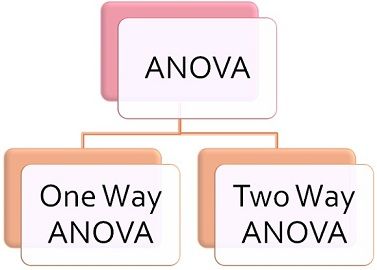 When it comes to research, in the field of business, economics, psychology, sociology, biology, etc. the Analysis of Variance, shortly known as ANOVA is an extremely important tool for analysis of data. It is a technique employed by the researcher to make a comparison between more than two populations and help in performing simultaneous tests. There is a two-fold purpose of ANOVA. In one way ANOVA the researcher takes only one factor.
When it comes to research, in the field of business, economics, psychology, sociology, biology, etc. the Analysis of Variance, shortly known as ANOVA is an extremely important tool for analysis of data. It is a technique employed by the researcher to make a comparison between more than two populations and help in performing simultaneous tests. There is a two-fold purpose of ANOVA. In one way ANOVA the researcher takes only one factor.
As against, in the case of two-way ANOVA, the researcher investigates two factors concurrently. For a layman these two concepts of statistics are synonymous. However, there is a difference between one-way and two-way ANOVA.
Content: One-Way ANOVA Vs Two-Way ANOVA
Comparison Chart
| Basis for Comparison | One Way ANOVA | Two Way ANOVA |
|---|---|---|
| Meaning | One way ANOVA is a hypothesis test, used to test the equality of three of more population means simultaneously using variance. | Two way ANOVA is a statistical technique wherein, the interaction between factors, influencing variable can be studied. |
| Independent Variable | One | Two |
| Compares | Three or more levels of one factor. | Effect of multiple level of two factors. |
| Number of Observation | Need not to be same in each group. | Need to be equal in each group. |
| Design of experiments | Need to satisfy only two principles. | All three principles needs to be satisfied. |
Definition of One-Way ANOVA
One way Analysis of Variance (ANOVA) is a hypothesis test in which only one categorical variable or single factor is considered. It is a technique which enables us to make a comparison of means of three or more samples with the help of F-distribution. It is used to find out the difference among its different categories having several possible values.
The null hypothesis (H0) is the equality in all population means, while alternative hypothesis (H1) will be the difference in at least one mean.
One way ANOVA is based on the following assumptions:
- Normal distribution of the population from which the samples are drawn.
- Measurement of the dependent variable is at interval or ratio level.
- Two or more than two categorical independent groups in an independent variable.
- Independence of samples
- Homogeneity of the variance of the population.
Definition of Two-Way ANOVA
Two-way ANOVA as its name signifies, is a hypothesis test wherein the classification of data is based on two factors. For instance, the two bases of classification for the sales made by the firm is first on the basis of sales by the different salesman and second by sales in the various regions. It is a statistical technique used by the researcher to compare several levels (condition) of the two independent variables involving multiple observations at each level.
Two-way ANOVA examines the effect of the two factors on the continuous dependent variable. It also studies the inter-relationship between independent variables influencing the values of the dependent variable, if any.
Assumptions of two-way ANOVA:
- Normal distribution of the population from which the samples are drawn.
- Measurement of dependent variable at continuous level.
- Two or more than two categorical independent groups in two factors.
- Categorical independent groups should have the same size.
- Independence of observations
- Homogeneity of the variance of the population.
Key Differences Between One-Way and Two-Way ANOVA
The differences between one- way and two-way ANOVA can be drawn clearly on the following grounds:
- A hypothesis test that enables us to test the equality of three or more means simultaneously using variance is called One way ANOVA. A statistical technique in which the interrelationship between factors, influencing variable can be studied for effective decision making, is called Two-way ANOVA.
- There is only one factor or independent variable in one way ANOVA whereas in the case of two-way ANOVA there are two independent variables.
- One-way ANOVA compares three or more levels (conditions) of one factor. On the other hand, two-way ANOVA compares the effect of multiple levels of two factors.
- In one-way ANOVA, the number of observations need not be same in each group whereas it should be same in the case of two-way ANOVA.
- One-way ANOVA need to satisfy only two principles of design of experiments, i.e. replication and randomization. As opposed to Two-way ANOVA, which meets all three principles of design of experiments which are replication, randomization, and local control.
Conclusion
Two-way ANOVA is often understood as an extended version of One way ANOVA. There are a number of advantages, due to which two-way ANOVA is preferred over One-way ANOVA, like with two-way ANOVA one can test the effects of two factors simultaneously.






Raksha says
Easy to understand for a fresher, loved it.
Graciela Tapia Perez says
Thanks for this excelent and clear text
Saprodia says
Thanks very much for sharing… Its been so helpful and understanding
roody says
can we use more than 2 independent variables in a 2 way Anova test??
Jyoti Bhardwaj says
Thanks! clearly put up information. Helped in understanding the concept.
công thức nấu ăn says
Why didn’t I see this article earlier for my thesis?
Altaye says
Really the information you delivered are very pertinent. Thank you!
arnel says
A very useful post for thesis
Harishchandra Shah says
Very useful and practical knowledge regarding differences of these concepts, also useful for avoiding confusions.